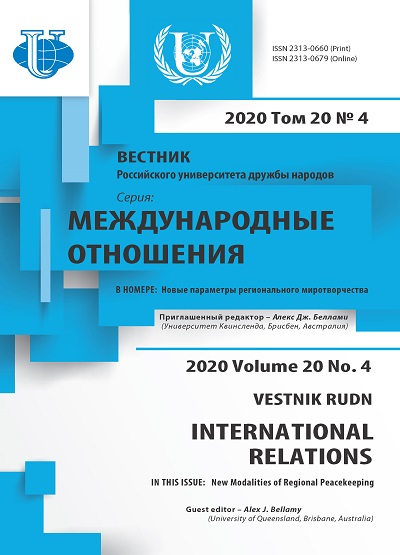Muslim Clergy vs. Authority in Contemporary Afghanistan: View from Uzbekistan
- Authors: Khaydarov A.A.1
-
Affiliations:
- Tashkent State University of Oriental Studies
- Issue: Vol 20, No 4 (2020): New Modalities of Regional Peacekeeping
- Pages: 747-762
- Section: PEACE AND SECURITY
- URL: https://journals.rudn.ru/international-relations/article/view/25280
- DOI: https://doi.org/10.22363/2313-0660-2020-20-4-747-762
Cite item
Full Text
Abstract
Significant geopolitical changes taking place in the modern world in recent decades urge us to take a fresh look at the role of Islam and the clergy in the political processes of a number of countries of the Muslim world. This perspective is especially relevant vis-à-vis Afghanistan where a fierce war is being waged under the slogans of Islam for more than four decades. The purpose of this research is an in-depth study of the relationship between the state and the Muslim clergy, Islamic institutions in the development of political processes in Afghanistan since the mid-70s of the last century. The article reflects shaping of the Islamic opposition and its efforts to stand up to innovations and reforms during attempts of the Soviet stile modernization in 1978-1992, and then the efforts to democratize Afghan society, undertaken in Afghanistan since the end of 2001 with the assistance of the international community. The work is based on the study of factual historical material, a chronicle of the events of the last decade and personal observations of the author during his work in Afghanistan during the mentioned period. Analytical materials published on the pages of English and Russian mass media were used. The methodological basis of this study is the comparative historical method; the article is based on the principles of historicism, reliability and scientific objectivity. The author concludes that the conflict is based on mistakes and underestimation by the state the role and influence of the Muslim clergy and Islamic institutions of the country. It has been noted that the recently reached US - Taliban agreements, as well as the assistance of such influential players as Russia, sparkle hope for the launch of a direct inter-Afghan negotiation process, which most likely will not be as simple but thorny.
About the authors
Abdusamat Akhatovich Khaydarov
Tashkent State University of Oriental Studies
Author for correspondence.
Email: akhat54@gmail.com
PhD, Dr. of Sc. (Political Science), Professor
Tashkent, Republic of UzbekistanReferences
- Akimbekov, S.M. (2003). Afghan Knot and Security Problems in Central Asia. Almaty. (In Russian).
- Barfield, T.J. (2012). Shari’a in Afghanistan. Review of Faith and International Affairs, 10 (4), 42—52. doi: 10.1080/15570274.2012.739886
- Dodwell, B. & Rassler, D.A. (2017). View from the CT Foxhole: General John W. Nicholson, Commander, Resolute Support and U.S. Forces — Afghanistan. Combating Terrorism Center at West Point, 10 (2), 12—16.
- Giustozzi, A. (2008). Afghanistan: Transition without End: An Analytical Narrative on State-Making. London: LSE Development Studies Institute.
- Giustozzi, A. (2012). Hearts, Minds, and the Barrel of a Gun: The Taliban’s Shadow Government. Prism, 3 (2), 71—80.
- Jackson, A. & Amiri, R. (2019). Insurgent Bureaucracy: How the Taliban Makes Policy. Washington: United States Institute of Peace.
- Jones, S.G. (2008). Counterinsurgency in Afghanistan. Santa Monica, CA: RAND National Defense Research Institute.
- Kadyrov, Sh. (1998). Turkmenistan in the 21st Century. Bergen: Bodoni Hus. (In Russian).
- Korgun, V.G. (2004). History of Afghanistan: 20th Century. Moscow: Kraft + publ. (In Russian).
- Martynkin, A. & Khomenko, S. (2014). Islam in the Afghan Conflict: Last Quarter of the Twentieth — Early Twenty-First Centuries. Central Asia and the Caucasus, 17 (4), 144—155. (In Russian).
- Nazarov, T. & Sattorzoda, A. (2006). Diplomatiyai muosiri tochik [Modern Tajik Diplomacy]. Dushanbe: Irfon. (In Tajik).
- Paramonov, V. (2000). Formation of the Geopolitical Situation in Central Asia — External Factors. Central Asia and the Caucasus, 1, 14—21. (In Russian).
- Plastun, V. & Andrianov, V. (1998). Najibulla. Afghanistan in the Grip of Geopolitics. Moscow: Biograficheskii Institut publ. (In Russian).
- Roy, O. (1994). The Failure of Political Islam. Cambridge: Harvard University Press.
- Slinkin, M.F. (1999). People’s Democratic Party of Afghanistan in Power (1978—1979). Simferopol: Simferopol’skii gosudarstvennyi universitet publ. (In Russian).
- Slinkin, M.F. (2005). Ethnic Problem in Afghanistan (Historical and Political Analysis). Culture of the Peoples of the Black Sea Region, 66, 46—60. (In Russian).
- Smagulov, A. (2013). Expert Review of the Impact of the Afghan Confrontation on the Political and Economic Situation in Central Asia. Bishkek: Universitet Tsentral’noi Azii publ. (In Russian).
- Spolnikov, V.N. (1987). Afghanistan: Islamic Counter-Revolution. Moscow: Nauka publ. (In Russian).
- Tariq, M.O., Borchgrevink, K. & Harpviken, K. (2011). Building Trust and Institutions. Religious Institution-Building in Afghanistan: An Exploration. Oslo: Peace Research Institute Oslo.
- Weigand, F. (2017). Afghanistan’s Taliban — Legitimate Jihadists or Coercive Extremists? Journal of Intervention and Statebuilding, 11 (3), 359—381. DOI: 17502977.2017.1353755
- Yuldasheva, G. (2013). The Iranian-Pakistani Factor in the Geopolitics of Central and South Asia. Central Asia and the Caucasus, 15 (2), 32—41.
- Zaeef, A.S. (2010). My Life with the Taliban. London: C. Hurst & Co.











